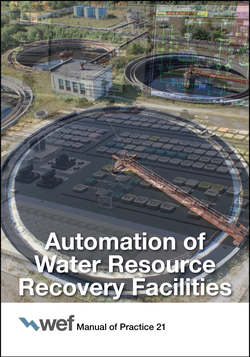Читать книгу Automation of Water Resource Recovery Facilities - Water Environment Federation - Страница 16
6.0 MANUAL OF PRACTICE CHAPTER CONTENTS
ОглавлениеEach chapter in this MOP is written to stand alone; therefore, readers looking for specific information can simply turn to the appropriate chapter. For more information on a particular topic, see the references or suggested readings sections included in most chapters.
In Chapter 2, a business case for automation is made, stressing that control systems can help utilities be more effective and efficient. Investments in automation can and should reduce labor, chemical, and power needs while improving performance and reliability. Both tangible and intangible costs and benefits are discussed. Several methodologies for financial analysis and the incorporation of risk and intangible benefits are presented.
In Chapter 3, elements of a complete automation design project are introduced. Each type of document (drawings, lists, and written material) is briefly discussed, and standards and references are delineated. Detailed descriptions of each element are provided.
Because of its importance to the design process, process and instrumentation diagrams (P&IDs) are described in depth in Chapter 4. Process and instrumentation diagrams are typically one of the first design documents developed for a project. Design elements of P&IDs are described and their interactions with other design documents are discussed. Recent developments in intelligent P&IDs are also introduced.
In Chapter 5, the process control narrative, a text-based method of describing a process control strategy, is discussed. Chapter 6 presents an introduction to writing specifications. It describes the Construction Specifications Institute format and provides details on what the various sections are and what content they contain.
Chapter 7 combines a tutorial on process-control basics, from feedback controllers to advanced model-based controls, with an updated version of the material from WEF’s (1997) Automated Process Control Strategies. It contains written descriptions of successful control strategies on a unit process basis for many of the most common wastewater treatment processes. The sections on control of dewatering, anaerobic digestion, and incineration have been updated and expanded.
In Chapter 8, general instrumentation characteristics, including properties and measures of accuracy, are introduced. Design considerations such as temperature, moisture, corrosion, and grounding are also discussed.
In Chapter 9, significant types of instrumentation used at WRRFs are discussed in detail. The discussion includes operating principles, materials of construction, error (incorrectly called accuracy in some literature), interferences, installation requirements, and maintenance requirements. In addition to common wastewater instruments, this section has been expanded to include measures of organic material (total organic carbon, biochemical oxygen demand, and chemical oxygen demand) and gas analysis.
In Chapter 10, final control elements are discussed. Topics include valves, valve actuators, pumps, pumping characteristics, blowers, blower characteristics, electric motors, starters, and variable-speed drives. In Chapter 11, communications and connectivity are discussed, largely in the form of a tutorial. This section has been heavily revised to include material on networking and new wireless communication technologies. Because of its dominance in the field, the use of Ethernet and protocols over Ethernet are discussed in detail.
In Chapter 12, physical and cyber security are discussed with an emphasis on cyber security of process control systems. New guidelines and recommendations from the Department of Homeland Security, the International Society of Automation, and the National Institute of Standards and Technology are referenced.
In Chapter 13, HMI is addressed. New developments in HMI design that emphasize rapid situational awareness and the role of the operator are presented. In addition, new standards and guidelines for alarming are introduced.
In Chapter 14, design of process controllers, including PLCs and DCSs, is discussed. This chapter of the manual has been abbreviated, and other readily available sources of similar information have been referenced.
Chapter 15 presents an introduction to instrumentation maintenance and troubleshooting. The chapter briefly discusses computerized maintenance management systems and emphasizes preventative maintenance as a strategy. Finally, in Chapter 16, control system training and training plan development are discussed.
